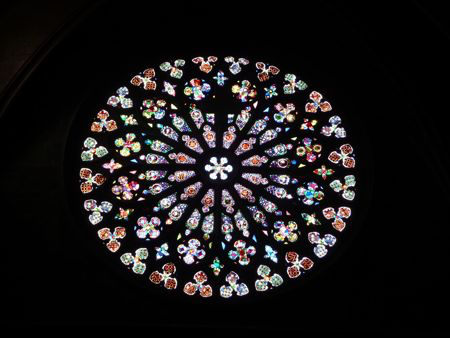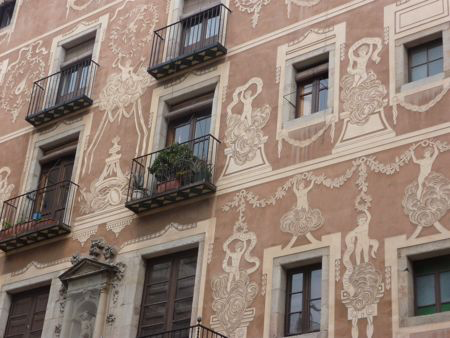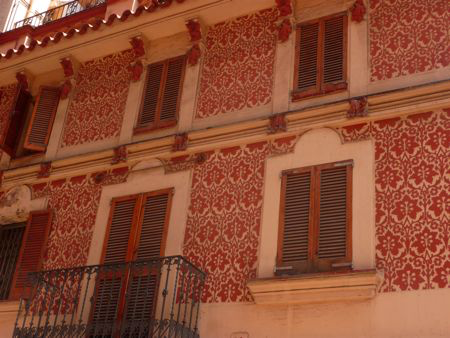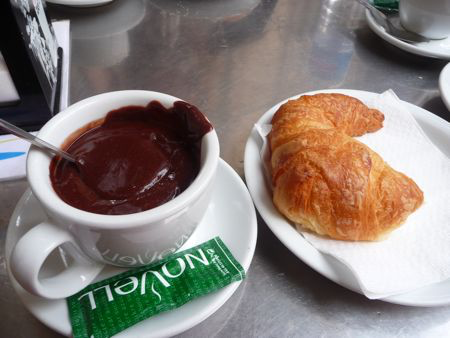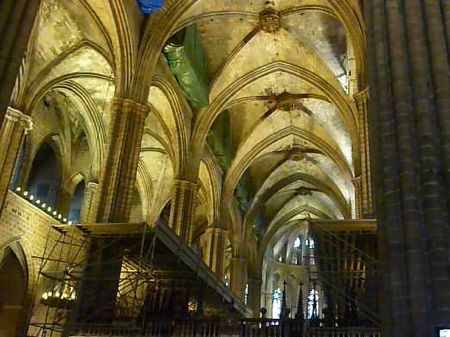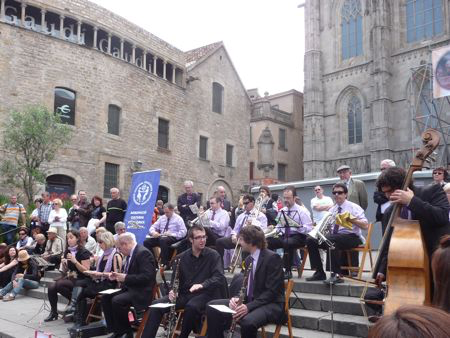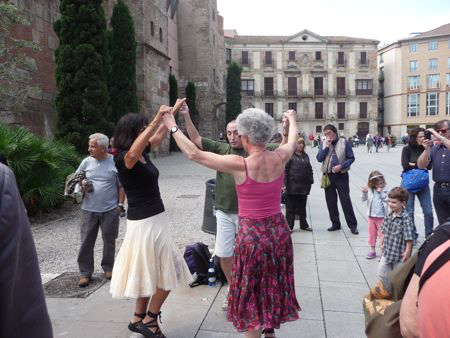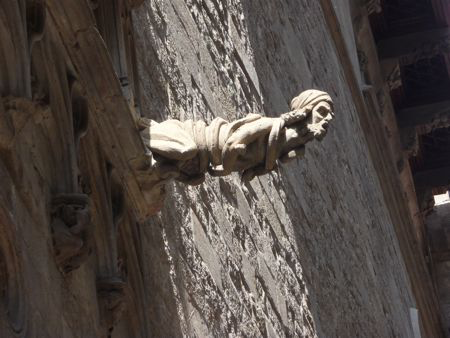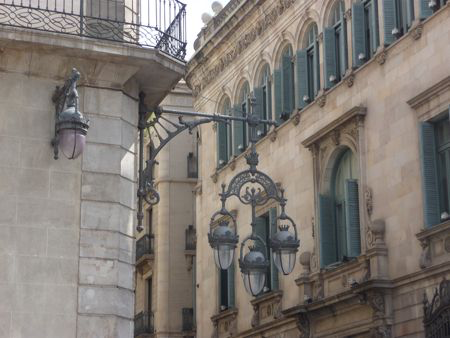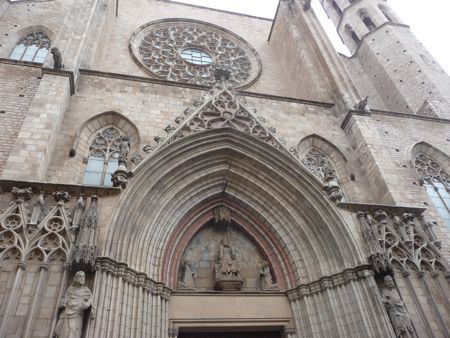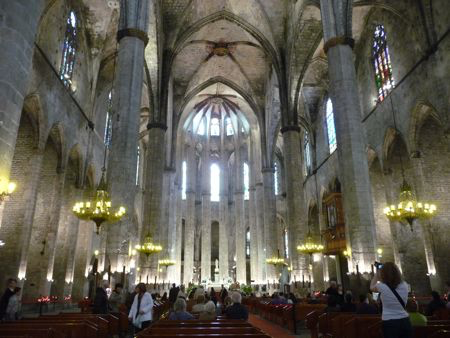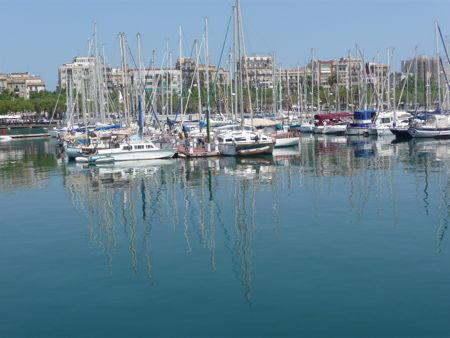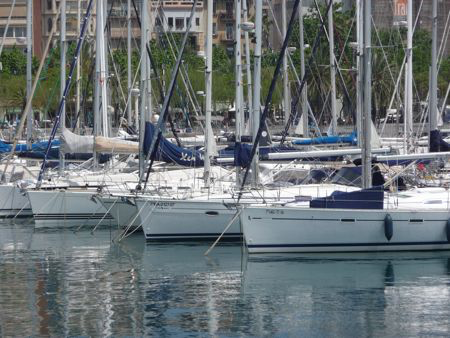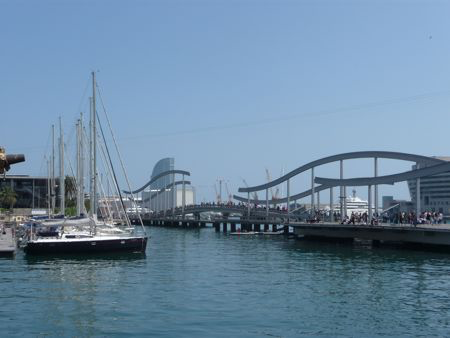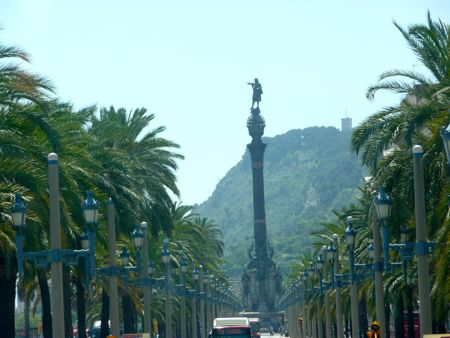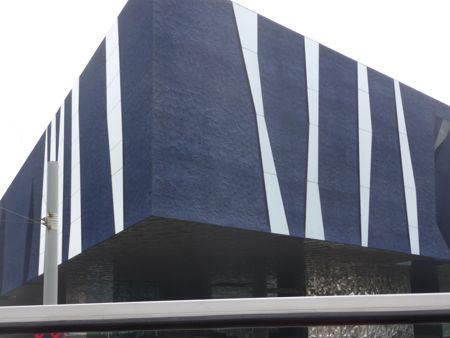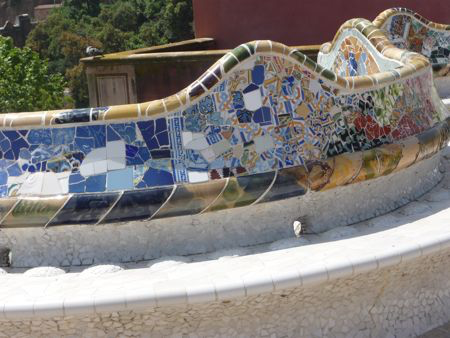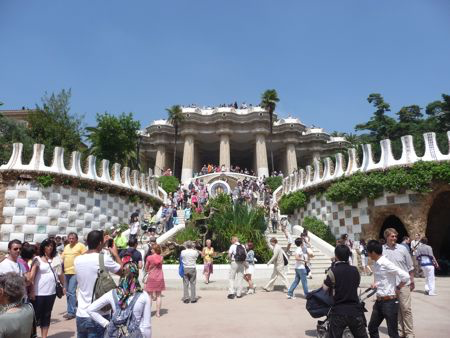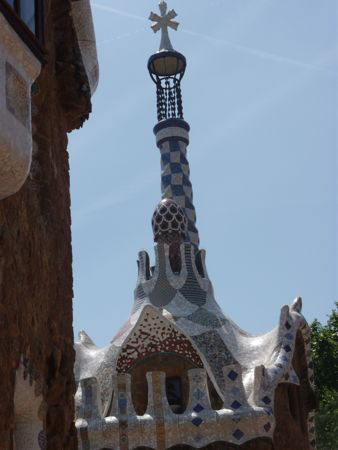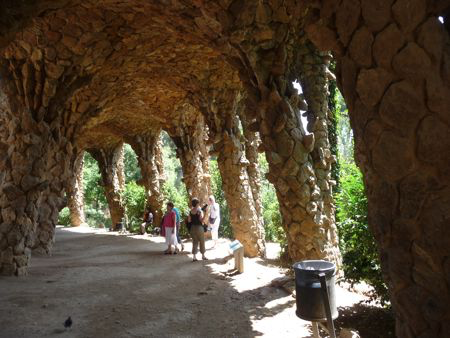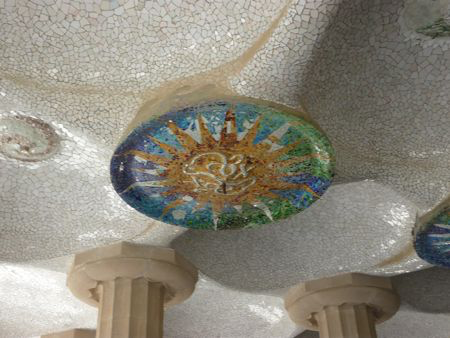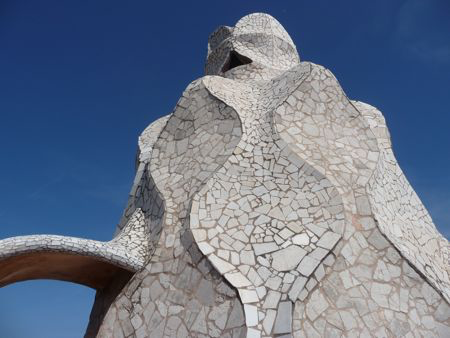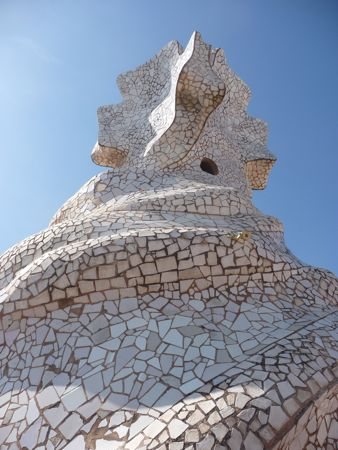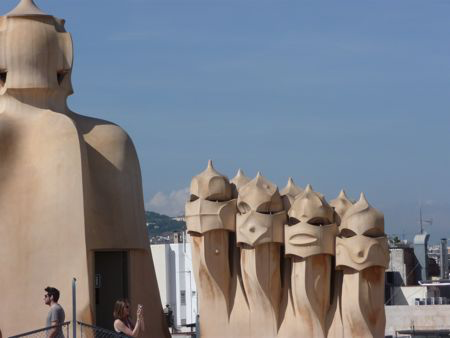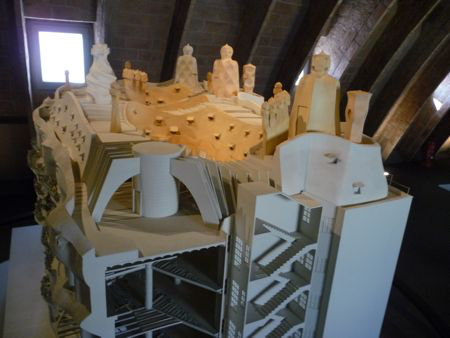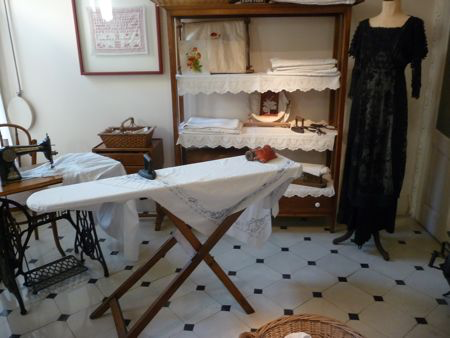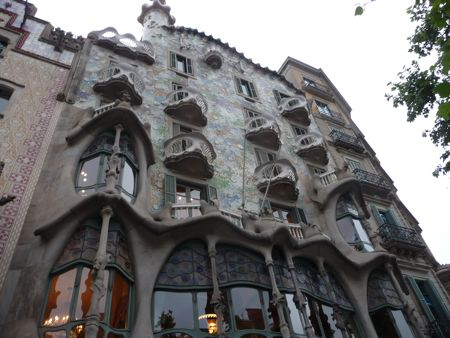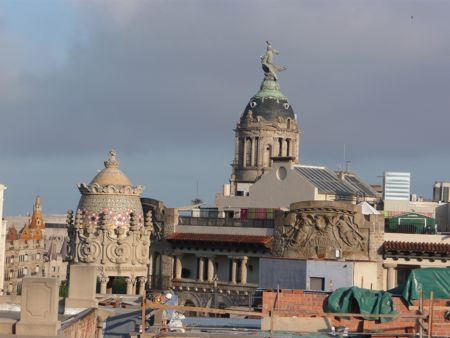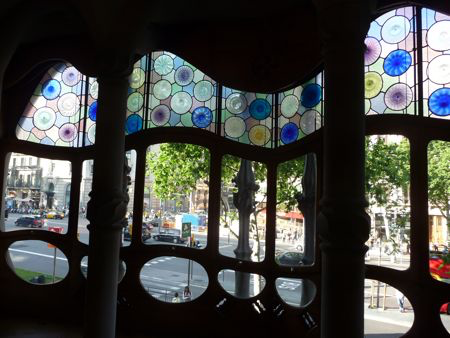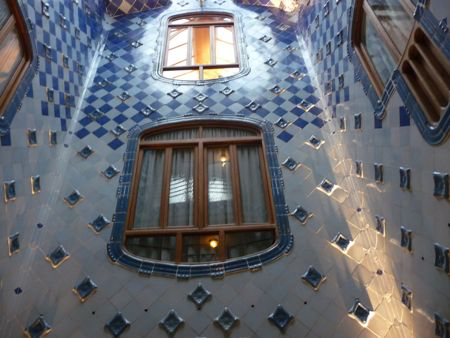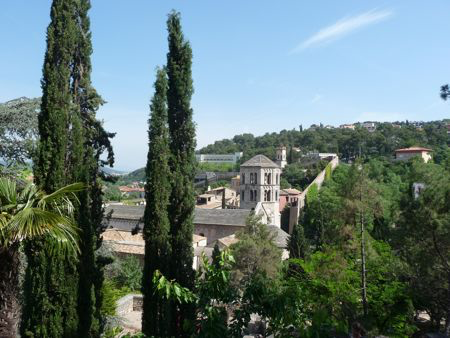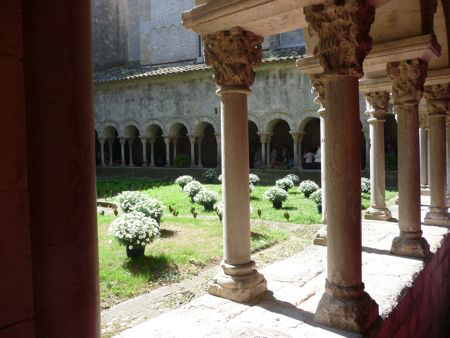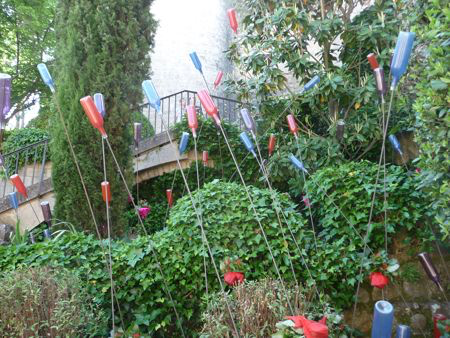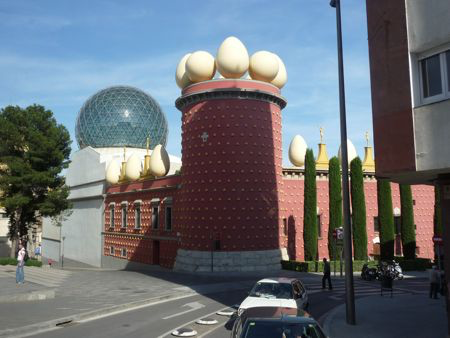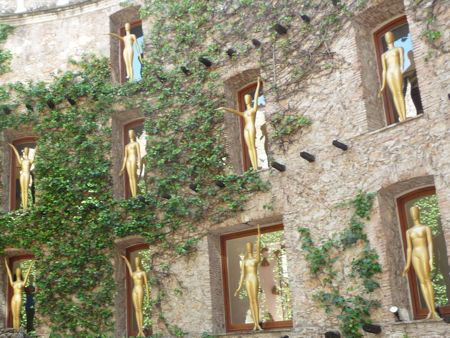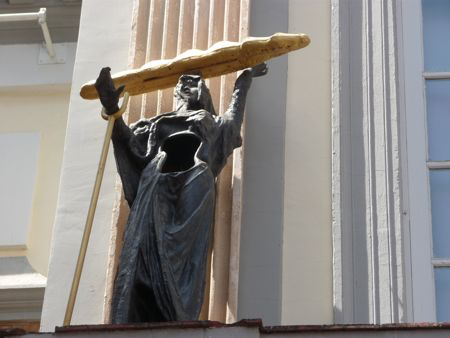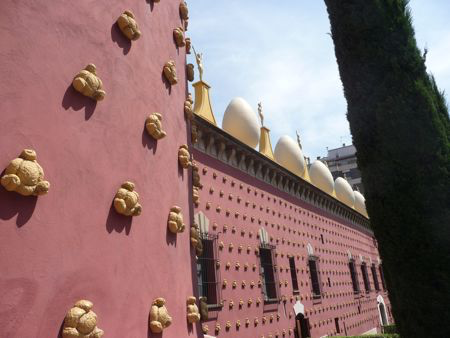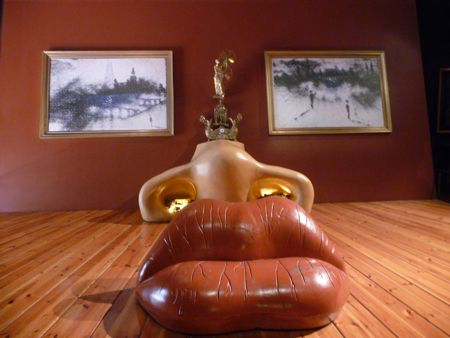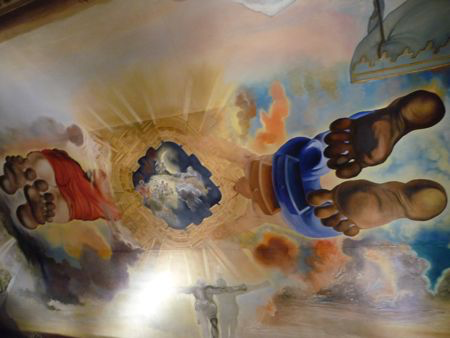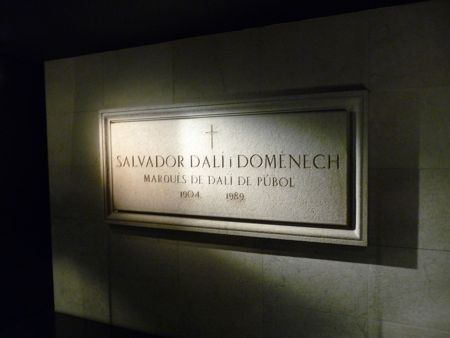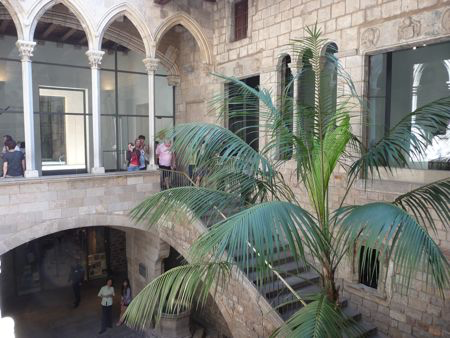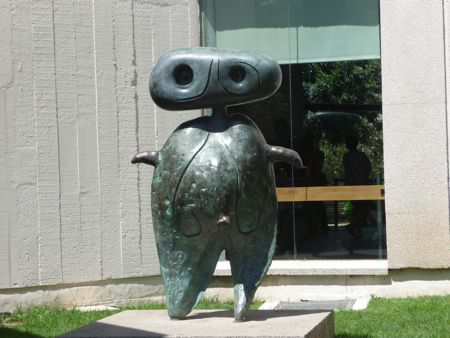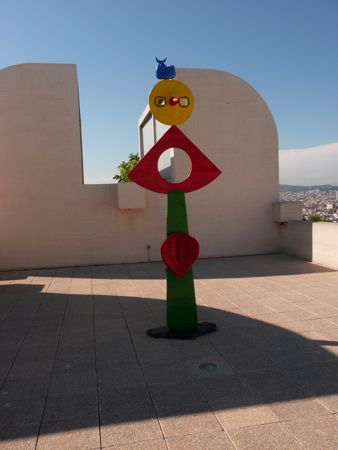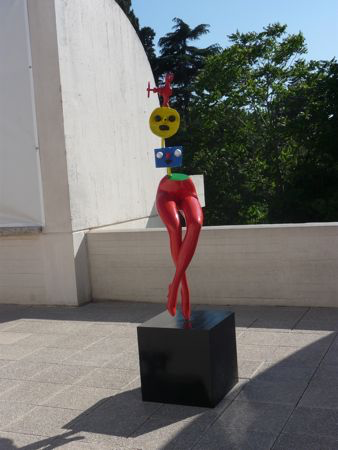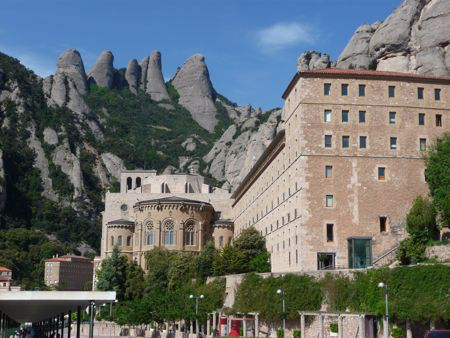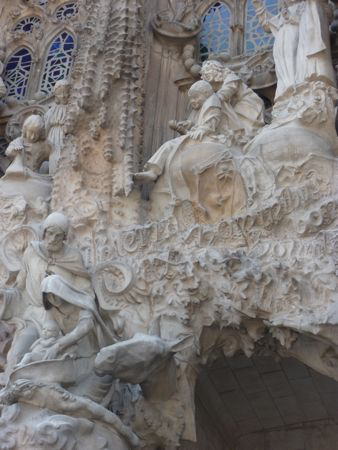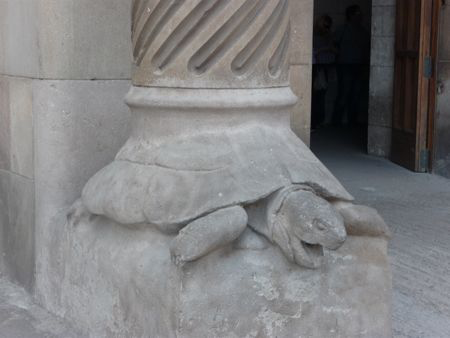May 2011
One city, one week… not quite forty days in the desert but still a good formula.
The city: Barcelona, the week… one in early May.We landed in Barcelona around noon. We were staying in an apparthotel right on La Rambla (or Las Ramblas as it is also called because it can be considered a series of shorter streets), possibly the most famous and busiest street in Barcelona. It is busy and can get noisy especially after a soccer win. But is great for exploring the city as it is next to the gothic quarters as well as close to Playa Catalunya where all the tourist buses leave from. Our room faced the back so we did not hear the street noises; instead, church bells serenaded us every fifteen minutes.
As our room was not ready, we decided to go for a walk to explore our surroundings. Our first stop was La Boqueria, a large farmers market. I was too tired to think of taking pictures but it was busy, lively and noisy, with all sorts of offerings from nuts and dried fruit to fish and seafood and all the fruits and vegetables you can think of. Restaurants and bars also surround the market. I tried to locate one that had been recommended on some website, but never found it so I ended up collapsing in the first available chair I found and got my first taste of the famous Tapas, which is another word for appetizers…. But more on that later.
After this refueling pause we returned to the hotel to settle into our room and unpack. Feeling refreshed after a change of clothing and wanting to adapt to the time change as quickly as possible, we set out again on foot to explore further. We set out this time for the Gothic quarter. This is the center of the old city of Barcelona. Many of the buildings date back to medieval times, some from as far back as the Roman settlement of Barcelona. You can see parts of the walls of the Roman city sometimes on their own and sometimes integrated into more recent buildings.
It felt as if each building has some adornment, be it color, sculpture, ironwork, windows or balconies. We kept on walking all the way to the Sagrada Familia cathedral. Quite a walk but ohh so worth it! No matter how many pictures you have seen, nothing prepares you for the size of it. It is huge… just walking around it takes close to 30 minutes. We did not go in, as it was late, promising instead to return at a later date.
On the way back we came upon a wonderful restaurant called De Tapa Madre where we had our first and probably best meal of the week. We just kept ordering more dishes as the evening went on… a series of tapas: fish, vegetables, meat, pasta and cheeses from a wide selection. Everything was delicious…and the service most pleasant.
http://www.detapamadre.cat/
We stumbled out close to midnight, as is often the case in Spain and went to bed. We had conquered the jet lag!
The next morning we set out for Gothic quarters again, this time stopping at three churches along the way. The first one, the Santa Maria del Pi cathedral had wonderful stained glass windows.
The walls on the buildings around the church were decorated with something that resembles Camay jewelry….
This is also where we stopped for a typical Catalan breakfast of hot chocolate and croissants. Actually it would have been more typical to have churros instead of croissants, but the chocolate was the big surprise for me. It is so thick that you must eat it with a spoon rather than drink it…needless to say it was wonderful.
We then walked over to the Barcelona cathedral. It is a beautiful gothic building tall and elegant but somewhat dark inside.
It is dedicated to Eulalia of Barcelona, co-patron saint of Barcelona, a young virgin who, according to Catholic tradition, suffered martyrdom during Roman times in the city. The church was undergoing repairs and there was a service going on when we walked in, so the choir was closed off allowing us only a limited view. When we came back outside we noticed a band setting up on the front steps and very soon they started playing and groups of people started dancing the sardana (a traditional Catalan dance) in the square, we were lucky to catch them as they only do this on Sundays.
After watching them for a while we walked around the church to the cloister. A serene atmosphere envelops the inner garden, where 13 white geese are kept, the number explained by the assertion that Eulalia was 13 when she was martyred.
Walking in this neighborhood was a feast for the eyes…
Our third church of the morning was Santa Maria Del Mar another gothic church and by far my favorite! It is said to have the slenderest stone built columns in the world. It is sober, simple, airy and elegant. It feels light and bright.
After this religious morning we set out for another neighborhood called La Barceloneta. This is an area bordered by the Mediterranean, lined with 5 kilometers of sandy beaches, allowing plenty of space for sun worshippers.
It was a fishermen’s village at some point but is now more famous for its restaurants, boardwalk and endless marinas. The ones I photographed were mostly for sailboats but there are motorboats also.
It is an easy walk along the water to the port and all its modern installations of restaurants and aquarium.
We concluded our excursion by walking by the statue of Christopher Columbus (that to me marks the separation between port and city) and then back up the Ramblas to our hotel.
That evening we went back to Santa Maria del Pi, to attend the guitar concert. It was held in a secondary chapel which created a more intimate feeling. The performer, Xavier Coll. played 4 different guitars, each from a different period and he played pieces popular in each time. It was lovely.
Walking back after the show we were amazed at how safe it feels. The streets are very well lit and people walk around late into the night. The locals often do not start eating supper before 10 PM.The next morning we chose to ride the hop on/hop off bus to get to the more remote attractions while getting a feel for the layout of the city. This allowed us to see the more modern sides of Barcelona. There are several very modern buildings, one of them resembles a huge bullet and is lit at night in multicolored hues. It cannot be visited but is the target of many jokes, because of its shape.
We also glimpsed at the science museum.
and the golden fish at the entrance to the Olympic park area.
But our focus on that day was Gaudi! Anton Gaudi is probably the most famous resident of Barcelona and has left his mark in several locations. The biggest is probably Park Güell. This was originally intended to become a high-end housing development up on the hill. The intention was to exploit the fresh air (well away from smoky factories) and beautiful views from the site, with sixty triangular lots being provided for luxury houses. This was the idea of Count Eusebi Güell, whom the park was named after. Unfortunately, only two houses were built there. Gaudi himself bought one and lived there, but as the project never took off, in time, the city took over and turned the area into a park. There are several architectural elements, such as a grand staircase and terrace lined with an undulating sea serpent bench in the decorated with his “trademark” colorful tiles.
That visit was somewhat disappointing: it was a long walk up the hill to get there, the place was crowded, the numerous paths did not seem to lead anywhere, but mostly because we never saw the famous dragon at the foot of the main staircase. I look at my photos of where it should be and all I see is greenery…so either it was hidden by plant material or it has been removed…
Maybe we should have prepared our visit better… or I was just too hot to appreciate, as there are some spectacular structures and decorations…
Our next stop on the Gaudi trail was the Pedrera house. Now THAT was a visit that was satisfying! What amazes me if that this man lived in the early 1900s yet he designed the most untraditional, unconventional, original, crazy houses ever! You start the visit of the Pedrera with the roof. It is like landing on another planet! The chimneys or ventilation towers look like alien figures…
Only after you go down the floors can you begin to understand what is involved in constructing such a building. There are small-scale models and videos to explain his techniques, his main originality being the use of arches called “catenary”.
The same technique was used to build the Sagrada Familia cathedral. Another floor down and you have the opportunity to visit an apartment as it was furnished back in the days of Gaudi. It makes the gap between the style of the house and the fashion of the times all the more impressive.
The striking thing about this apartment is the light that comes not only from the outside windows but also from an inner courtyard that lights up the center of each apartment.
The next Gaudi house we visited, on the same street, Passeig de Gracià, is known as Casa Batllo. This one has an even more exuberant façade. Some have compared it to bones. To me, the balconies look like masks.
The whole house is covered in “Trencadis” (broken up ceramic tiles) and the roof is arched like the back of a dragon. The roof top terrace is interesting although not as spectacular as the previous one. Here the chimneys are covered in mosaic.
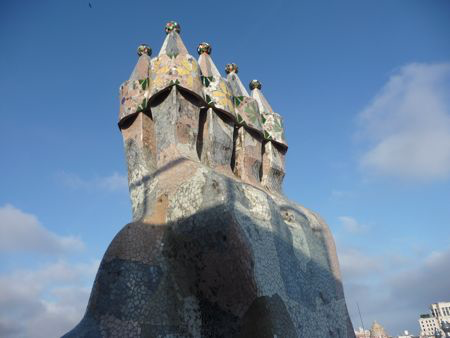
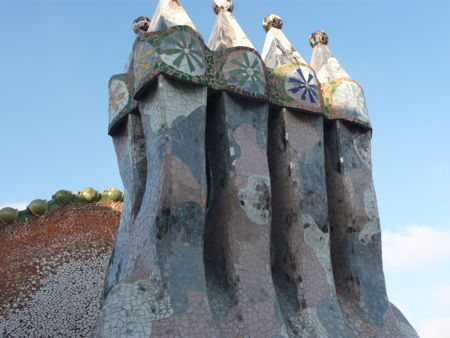
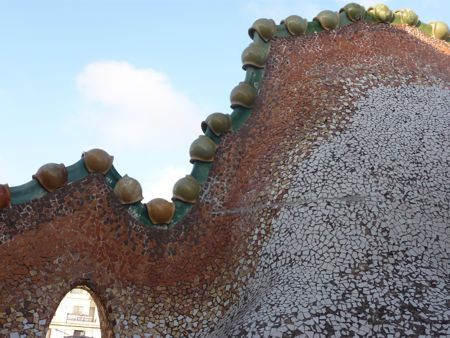
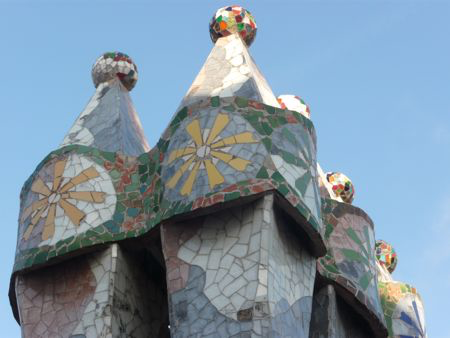
The view from up there is again spectacular.
Everything is curved or undulating in this house the windows, the archways…
The woodwork and stained glass windows give an impression of richness. In the core of the building, an elevator rides along a light well that is entirely tiled in blue. But the color intensity varies as you ascend from very light blue to a deep blue near the top to accentuate the impression of depth.
After Gaudi, Dalí was our next target, so the following day we booked a tour to the Dalí Museum in Figueres. We stopped in Girona on the way; this is a gem of a village. The only downside was that we landed in the middle of their flower festival, which made for unusual crowds. I would like to go back on a quieter day to just take in the views and visit their gothic churches and other monuments.
The flower theme is taken very loosely … as you can see in this arrangement of toilet brushes…and bottles
But the true purpose of our excursion was the Dalí Museum in Figueres! Right from the first glimpse you KNOW this is not an ordinary building…
it is topped with gigantic eggs and “Oscar like” statues
as well as Greek looking statues carrying loaves of bread on their heads
and the red walls are dotted with small yellow blobs (I will let you decide what those remind you of…).
Dalí created this Theatre-Museum, the largest surrealistic object in the world, over the former Municipal Theatre, a 19th century construction, which was destroyed at the end of the Spanish Civil War. So there are parts of the old building still standing inside this new one. It is hard to describe the inside, as it is very Dalíesque… There is a very bright courtyard topped in part by a geodesic dome and occupied by a Cadillac and his wife Gala’s boat, together with the Esther Queen by Ernst Fuchs, an impressive woman…to say the least.
Currently, in one of the main rooms there are some of the same huge canvases as in the Tampa museum that I had trouble with because I could only see one of the images. In this case it was a picture of Gala Nude Looking at the Sea which turns into a picture of President Lincoln at a certain distance… strangely only when I took a photo of it could I finally see the Mister Lincoln.
There is a Marilyn Monroe room…
There is an impressive mural (how does one call a ceiling painting?) in the palace of the wind…
There are several paintings by other artists that are from his personal collection, as well as a display of his jewelry designs… There is a surprise at every turn…Dali is even buried there.
I would have loved to have known this man. He had such imagination!
And that was our Dali day! After visiting his Tampa museum three times and now this one, I feel a bit more comfortable with his work.From one creator to the next, the following day we visited the Picasso museum. It is set in a series of beautiful old buildings, but photography is forbidden…
The one display that absolutely fascinated me was one where we are shown a series of 58 interpretations of Velasquez’s Las Meninas, and figures from it. Picasso did not vary the characters within the series, but painted them in his own way. According to the museum, his works constitute an “exhaustive study of form, rhythm, color and movement”. I found it helpful to be shown what he was looking at and how he transformed it to make it his own…
http://cablearms.com/2011/03/20/mujer-con-mantilla/
http://www.bcn.cat/museupicasso/en/collection/mpb70-433.html
Our next stop that day was the Miro museum.
He is another native who turned out to be an incredibly creative and successful artist. What amused me about him was how ordinary he and his wife looked in his photographs. Yet I feel he was the most audacious of all the artists we got to learn about on this trip. This is a large museum and he was a prolific artist. Once again no photography except on the terrace.
The following day we once again set off on an excursion out of town, this time to the hillside village and monastery of Montserrat.
Its claim to fame (among other things) is a black virgin statue probably dating back to the 12th century. Legend has it that the Benedictine monks could not move the statue to construct their monastery, choosing to instead build around it. The statue’s sanctuary is located at the rear of the chapel, set on a gold altar.
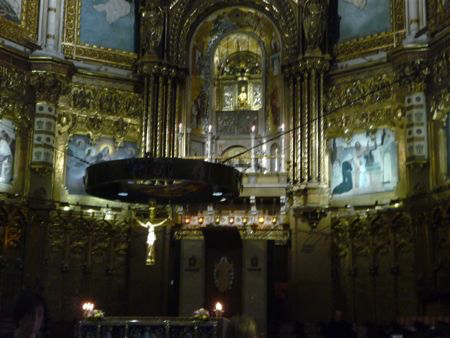
It is said that, upon his recovery from battle wounds, Ignatius of Loyola visited the Benedictine monastery of Montserrat (March 25, 1522), where he laid down his military accoutrements before the image. Then went through a period of asceticism before later founding the Society of Jesus. We were able to attend mass which was all in Spanish. What amused me was that the host tasted of olive oil reminding me of chips. The area offers lovely views and pretty flowers, but is very touristy with numerous souvenir shops and stalls. I did buy some lovely honey…and a bottle of Crema Catalana, a crème brulée flavored liqueur.
Our trip was nearing the end and we still had two landmarks to visit: the Sagrada Familia and the Music Palace.
Approaching the cathedral is daunting especially when the line-up to get in wraps around the block, but it was well worth the wait.
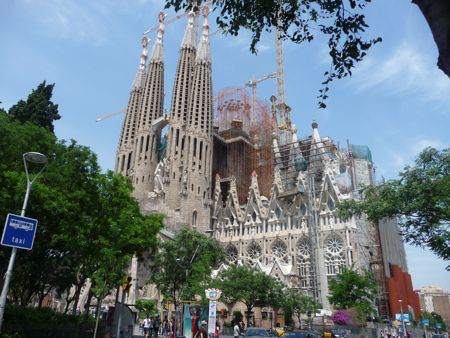

This construction started in 1882! Gaudí devoted his last years to the project, but at the time of his death in 1926, less than a quarter of the project was complete. The main nave was covered and the organ installed in mid-2010, allowing the still unfinished building to be used for religious services. Pope Benedict XVI consecrated the church on 7 November 2010.
Gaudí’s original design calls for a total of eighteen spires, representing in ascending order of height the Twelve Apostles, the four Evangelists, the Virgin Mary and, tallest of all, Jesus Christ. The Church will have three grand façades: the Nativity façade to the East, the Passion façade to the West, and the Glory façade to the South (yet to be completed).
The Nativity façade was the first façade to be completed. Dedicated to the birth of Jesus, it is decorated with scenes reminiscent of elements of life; the sculptures are ornately arranged and decorated with scenes and images from nature.
In contrast to the highly decorated Nativity Façade, the Passion Façade is austere, plain and simple, with ample bare stone, and is carved with harsh straight lines to resemble a skeleton. The façade was intended to portray the sins of man. Gaudí intended for this façade to strike fear into the onlooker.
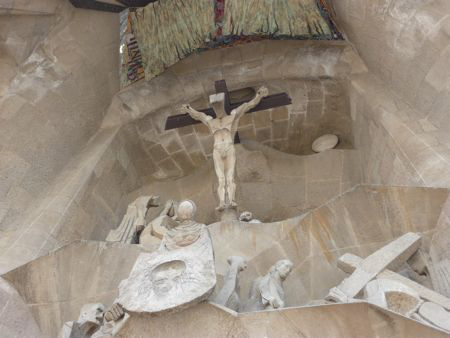

Inside, the church plan is that of a Latin cross with five aisles. The central nave vaults reach forty-five meters while the side nave vaults reach thirty meters. The central vault reaches sixty meters. The columns of the interior are a unique Gaudí design. Besides branching to support their load, their ever-changing surfaces are the result of the intersection of various geometric forms. The simplest example is that of a square base evolving into an octagon as the column rises, then a sixteen-sided form, and eventually to a circle. This effect is the result of a three-dimensional intersection of helicoidal columns (for example a square cross-section column twisting clockwise and a similar one twisting counter-clockwise).
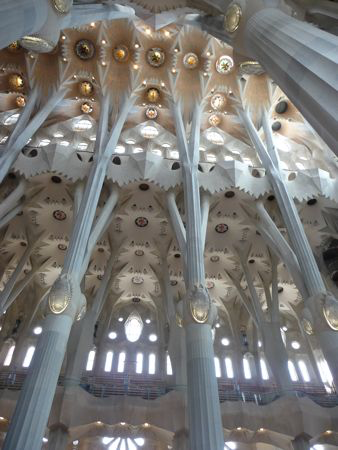
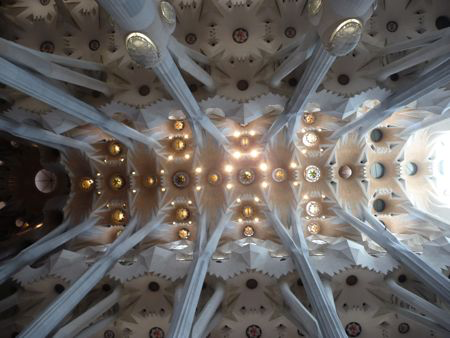
Not all stained glass windows are in but the ones that are, are beautiful


The Music Palace was another must see for me. It is a concert hall opened in 1908 that was originally built for a choir group. We first took a guided tour but wanted more, so we got tickets to a concert that evening in order to enjoy it even more. The décor is very eclectic, ornate and feminine to a certain extent as there are flowers everywhere, but the overall feeling is magnificent!
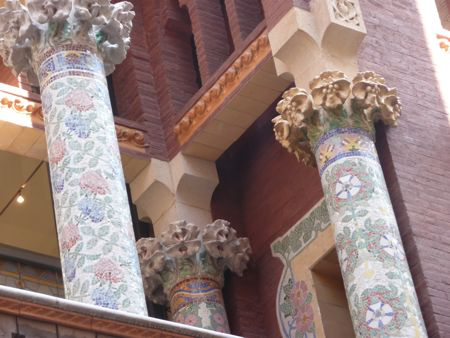
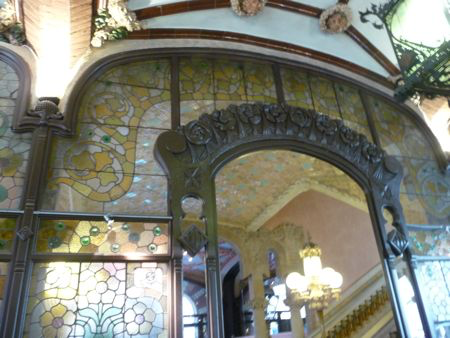
The piece de resistance is the glass ceiling light, a breathtaking burst of color…

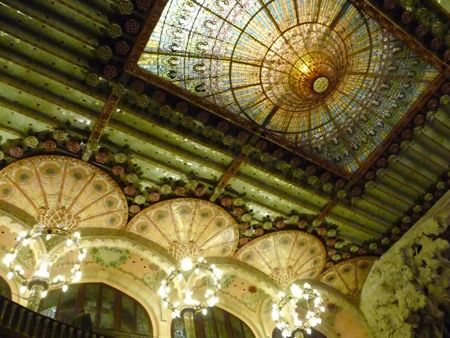
Ceramic, mosaic and glass flowers and decorative elements surround it. Behind the stage there are sculptures coming out of the walls, the ride of the Walkiries on one side, Beethoven on the other, and female figures holding a variety of musical instruments in the middle.
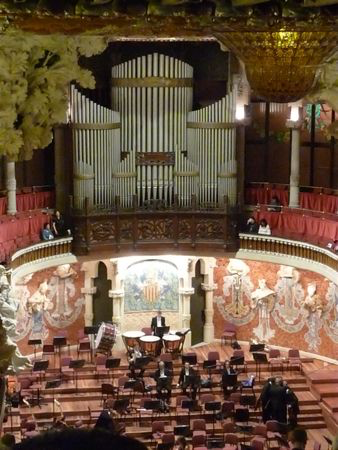
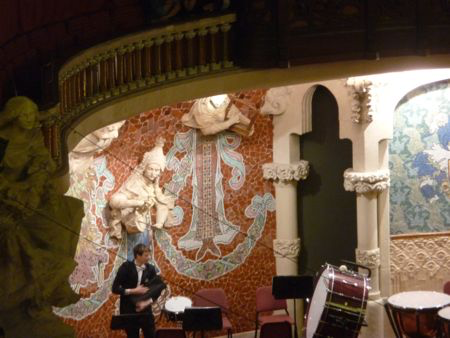
The walls are stained glass…Even the outside is ornate although it is harder to see, as the building is located very close to its neighbors.

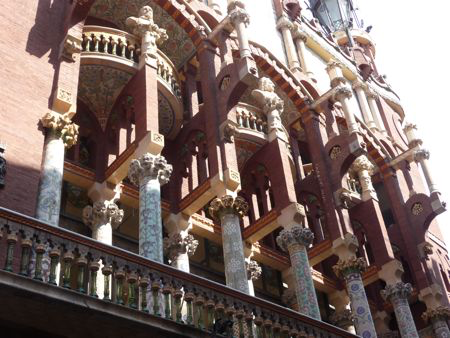
We had time to wander the streets a bit more and happened to walk into the university grounds…beautiful buildings and courtyards…

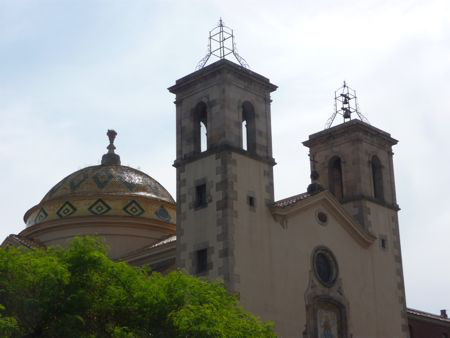
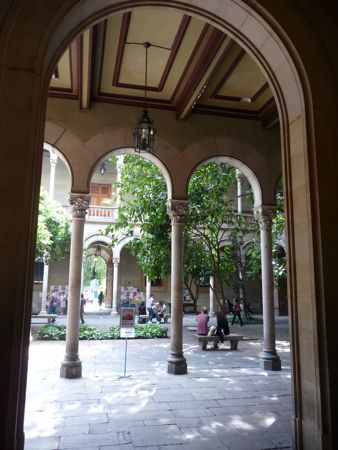
And topped the week off with a meal at a very attractive (and yes touristy) tapas bar. Here you pick what you want off the very long and lavish display and then get billed by the number of wooden picks you are left with, as each piece has a pick in it.
I thought these were some kind of pasta, but they were not. They tasted more like octopus or squid or something… very different…
Can you tell I had a good time???
The return flight got changed from afternoon to very early morning, which meant that we had to wake up at 4 am to be ready to drag our very heavy suitcases up three blocks to catch the Airport shuttle before sunrise.
Once in the airport I discovered, after standing in line for a long time, that you have to request the VAT tax refund cheques IN the shops, so that you have them in hand when you arrive at the airport to present at customs for stamping. Only then can you cash them…Live and learn.
I had paid extra for an exit row seat which ends up being a tradeoff because those seats although offering extra leg room are narrower than others because the tray is in the armrest. I was seated next to a rather large and clumsy gentleman who managed to drop a suitcase on my head as he was rummaging through the overhead bin, and later spilled a full glass of wine over my lap. It was a long flight of over 8 hours because of the winds. But I made it home safe and sound…with lots of photos and memories of a wonderful trip in a unique city that has the most amazing mix of modern and antique art and architecture.

